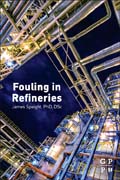
Fouling in Refineries is an important and ongoing problem that directly affects energy efficiency resulting in increased costs, production losses, and even unit shutdown, requiring costly expenditures to clean up equipment and return capacity to positive levels. This text addresses this common challenge for the hydrocarbon processing community within each unit of the refinery. As refineries today face a greater challenge of accepting harder to process heavier crudes and the ongoing flow of the lighter shale oil feedstocks, resulting in bigger challenges to balance product stability within their process equipment, this text seeks to inform all relative refinery personnel on how to monitor fouling, characterize the deposits, and follow all available treatments. With basic modeling and chemistry of fouling and each unit covered, users will learn how to operate at maximum production rates and elongate the efficiency of their refinery's capacity. Presents an understanding of the breakdown of fouling per refinery unit, including distillation and coking unitsProvides all the factors, crude types, and refining blends that cause fouling, especially the unconventional feedstocks and high acid crudes used todayHelps users develop an analysis-based treatment and control strategy that empowers them to operate refinery equipment at a level that prevents fouling from occurrin INDICE: Preface Chapter 1: The Structure of Petroleum Chapter 2: Fouling and Asphaltene Constituents Chapter 3: Factors Influencing Fouling Chapter 4:Fouling in Refineries Chapter 5: Fouling during Distillation Chapter 6: Fouling during Visbreaking Chapter 7: Fouling during Coking Chapter 8: Fouling during Catalytic Cracking Chapter 9: Fouling in Hydroprocesses Chapter 10: Fouling in Gas Cleaning Chapter 11: Fouling Treatment and Control Glossary Index
- ISBN: 978-0-12-800777-8
- Editorial: Gulf Professional Publishing
- Encuadernacion: Rústica
- Páginas: 512
- Fecha Publicación: 01/06/2015
- Nº Volúmenes: 1
- Idioma: Inglés
